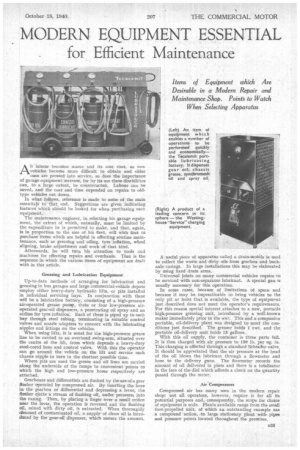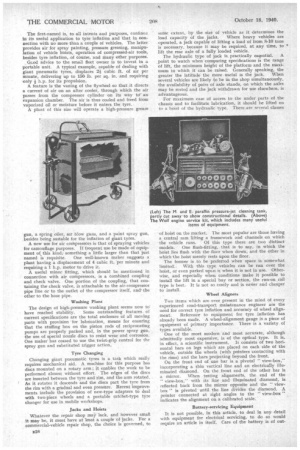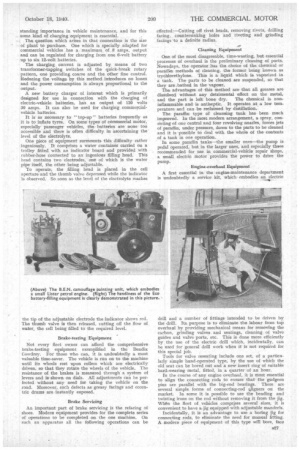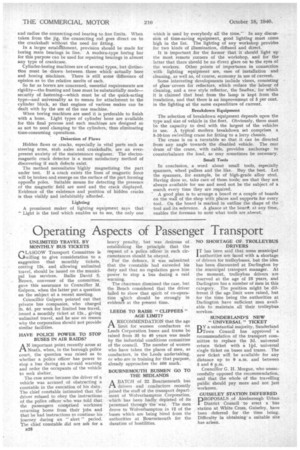MODERN EQUIPMENT ESSENTIAL
Page 59

Page 60

Page 61

Page 62

If you've noticed an error in this article please click here to report it so we can fix it.
for Efficient Maintenance
Items of Equipment which Are Desirable in a Modern Repair and Maintenance Shop. Points to Watch When Selecting Apparatus
AS labour becomes scarce and its cost rises, as new vehicles becoine more difficult to obtain and older ones are pressed into service, so does the importance of garage equipment increase, for by its use these disabilities can, to a large extent, be counteracted. Labour can be saved, and the cost and time expended on repairs to oldtype vehicles cut down.
In what follows, reference is made, to some of the main essentials to that end. Suggestions are given indicating features' which should be looked for when purchasing such equipment.
The maintenance engineer, in selecting his garage equipment, the extent of which, naturally, must be limited by the expenditure he is permitted to make, and that, again, is in proportion to the size of his fleet, will wish first to purchase items which are helpful in effecting routine maintenance, such as greasing and oiling, tyre inflation, wheel aligning, brake adjustment and work al that kind.
Afterwards, he will turn his attention to tools and machines for effecting repairs and overhauls. That is the sequence in which the various items of equipment are dealt with in this article.
Greasing and Lubrication Equipment Up-to-date methods of arranging for lubrication and greasing in bus garages and large commercial-vehicle depots employ either heavy-duty hydraulic lifts, or pits installed in individual servicing bays. In conjunction with these will be a lubrication battery, consisting of a high-pressure air-operated grease pump, three or four low-pressure airoperated gear-oil dispensers, a penetrating oil spray and an airline for tyre inflation. Each of these is piped up to each bay through steel tubing, terminating in suitable control valves and nozzle adapters to connect with the lubricating nipples and fittings on the vehicles.
When using lifts, it is usual for the high-pressure grease line to be carried to an overhead swing-arm, situated over the centre of the lift, from which depends a heavy-duty steel-cored hose and control valve. With this the operator can go around the vehicle on the lift and service each chassis nipple in turn in the shortest possible time. Where pits are used the grease and oil lines are carried along the underside of the ramps to convenient points to which the high and low-pressure hoses respectively are attached.
Gearboxes and differentials are flushed by the use of a gear flusher operated by compressed air. By inserting the hose in the gearbox or differential and depressing a lever, the flusher ejects a stream of flushing oil, under pressurei into the casing. Then, by placing •a finger over a small orifice near the lever, the operation is reversed and the flushing oil, mixed with dirty oil, is extracted. When thoroughly -cleansed of contaminated oil, a supply of clean oil is introduced by the gear-oil dispenser, which meters the amount. A useful piece of apparatus called a drain-mobile is used to collect the waste and dirty oils from gearbox and backaxle casings. In large installations this may be elaborated by using fixed drain arms.
Universal joints on many commercial vehicles require to be serviced with non-separator lubricant. A special gun is usually necessary for this operation.
In some cases, because of limitations of space and because it may be impracticable to bring vehicles to the only pit or hoist that is available, the type of equipment just described does not meet the operator's requirements. • For this reason special interest attaches to a new, portable high-pressure greasing unit, introduced by a well-known maker immediately prior to the war. This and a companion portable, oil-delivery plant was designed to meet the conditions just described. The greaser holds 1 cwt. and the portable oil-delivery unit holds 15 gallons.
With this oil supply, the container is three parts full. It is then charged with air pressure to 150 lb. per sq. in. This charging is effected through a standard Schrader valve. It should be appreciated that the air pressure at the head of the oil blows the lubricant through a flowmeter and hose to the delivery guns. The flowmeter records the amount of oil delivered in pints and there is a totalisator in the face of the dial which affords a check on the quantity passed through the meter.
Air Compressors Compressed air has many uses in the modern repair shop: not all operators, however, require it for all its potential purposes and, consequently, the scope for choice of equipment is wide. Plants available range from the small foot-propelled unit, of which an outstanding example has a compound action, to large stationary plant with pipes and pressure points located throughout the premises. The first-named is, to all intents and purposes, confiniiii in its useful application to tyre inflation and that in connection with no more than a couple of vehicles. The latter provides air for spray painting, pressure greasing, manipulation of vehicle hoists, operation of compressed-air tools, besides tyre inflation, of course, and many other purposes.
Gcod advice to the small fleet owner is to invest in a portable unit. A typical example, capable of dealing with giant pneumatic tyres, displaces 2i cubic ft. of air per minute, delivering up to 150 lb. per sq. in. and requiring only h.p. for its propulsion.
A feature is the vaning of the flywheel so that it directs a current of air on an after cooler, through which the air passes from the compressor cylinder on its way to an expansion chamber. The air is thus cooled and freed from vaporized oil or moisture before it enters the tyre.
A plant of this size will operate a high-pressure grease gun, a spring oiler, air blow guns, and a paint spray gun, besides being suitable for the inflation of giant tyres.
A new use for air compressors is that of spraying vehicles for camouflage purposes. If frequent use be made of equipment of this kind,. something a little larger than that just named is requisite. One well-known maker suggests a plant having a displacement of 4 cubic ft. per minute and requiring a 1 h.p. motor to drive it.
A useful minor fitting, which should be mentioned in connection with air compressors, is a combined coupling and check valve. One portion of the coupling, that containing the check valve, ia attachable to the air-compressor pipe line or to the outlet of the compressor itself, and. the other to the hose pipe.
Washing Plant The design of high-pressure washing plant seems now to
have reached stability. Some outstanding features of current specifications are the total enclosure of all moving parts with provision for lubrication, means for ensuring that the stuffing box on the piston rods of reciprocating pumps are properly packed and, in the power spray gun, the use of special nozzle discs to resist wear and corrosion. One maker has ceased to use the twist-grip control for the spray gun and substituted trigger action.
Tyre Changing
Changing giant pneumatic tyres is a task which really requires mechanical aid. A machine for this purpose has discs mounted on a rotary arm; t enables the work to be performed almost without effort. The edges of the discs are inserted between the tyre and rim, and the arm rotated. As it rotates it descends and the discs part the tyre from the rim with a gradual and even pressure. Recent improvements include the provision of new-type adapters to deal with two-piece wheels and a portable ratchet-type tyre changer for use in mobile workshops.
Jacks and Hoists
Whatever the repair shop may lack, and however small it may be, it must have at least a couple of jacks. For a commercial-vehicle repair shop, the choice is governed, to
some extent, by the size of vehicle as it determines the
load capacity of the jacks. Where heavy vehicles are operated, a jack capable of lifting a load of from 8-10 tons is necessary, because it may be required, at any time, to • lift the rear axle of a fully loaded vehicle.
The hydraulic type of jack is practically essential. A point to watch when comparing specifications is the range of lift, the minimum height of the platform and the maximum to which it can be raised. Generally speaking, the greater the latitude the more usetul is the jack. When several vehicles are likely to be in the shop simultaneously, the availability of pairs of axle stands, on which the axles may be rested and the jack withdrawn for use elsewhere, is advantageous.
For maximum ease of access to the under parts of the chassis and to facilitate lubrication, it should be lifted on to a hoist of the hydraulic type. There., are several classes of hoist on the market. The most popular are those having a central ram lifting a framework and channels on which the vehicle runs. Of this type there are two distinct models. One flush-fitting, that is to say, in which the hoist lies flush with the-floor when down, and the other in which the hoist merely rests upon the floor.
The former is to be preferred when space is somewhat limited., With this type vehicles can be run over the hoist, or even parked upcn it when it is not in use. Otherwise, and especially when conditions make it possible to install the lift in a special bay or section, the run-on rail type is best. It is not so costly and is easier and cheaper to install.
Wheel Aligners Two items which are ever present in the mind of every experienced road-transport rnaiatenance engineer are the need for correct tyre inflation and accuracy of wheel align
ment. Reference to equipment for tyre inflation has already been made. A wheel-alignment gauge is a piece of equipment of primary importance. There is a variety of types available.
One of the most modern and most accurate, although admittedly most expensive, is of the optical type. It is, in effect, a scientific instrument. It consists of two horizontal bars on legs which are placed on each side of the vehicle, outside the wheels (with pointers contacting with the rims) and the bars projecting beyond the front.
On the front end of one bar is a pivotal " view-box," incorporating a thin vertical line and an electrically illuminated diamond, On the front end of the other bar is a mirror. When testing alignments, the end of the " view-box," with its line and illuminated diamond, is reflected back from the mirror opposite and the '' viewbox" is pivoted until the line divides the diamond. A pointer connected at right angles to the " view-box " indicates the alignment on a calibrated scale.
Battery-servicing Equipment It is not possible, in this article, to deal in any detail with equipmeat for electrical servicing, to do so would require an article in itself. Care of the battery is of out
standing importance in vehicle maintenance, and for this some kind of charging equipment is essential. ,.
The. question which arises in that connection is the size of plant to purchase. One which is specially adapted for commercial vehicles has a• maximum of 8 amps. output and can be regulated for charging from one 6-volt battery up to six 12-volt batteries.
The charging current is adjusted by means of two transformer-tapping switches of the quick-break rotary pattern, one providing coarse and the other fine control. Reducing the voltage by this method introduces no losses and the power consumption is always proportional to the output.
A new battery charger of interest which is primarily designed for use in connection with the charging of electric-vehicle batteries, his an output of 120 volts 30 amps. It can also be used for charging commercialvehicle batteries.
It is as necessary to "top-up" batteries frequently as it is to inflate tyres. On some types of commercial motor, especially passenger vehicles, the batteries are none too accessible and there is often difficulty, in ascertaining the level of the electrolyte.
One piece of equipment surmountsthis, difficulty rather ingeniously. It comprises a water container carried on a trolley fitted with an indicator board and provided with rubber-hose connected to an ingenious filling head. This head contains two electrodes, one of which is the water pipe itself, the other being adjustable.
To operate, the filling head is placed in the cell aperture and the thumb valve depressed while the indicator is observed. So soon as the level of the electrolyte reaches the tip of the adjustable electrode the indicator shows red_ The thumb valve is then released, cutting off the flow of water, the cell being filled to the required level.
Brake-testing Equipment Not every fleet owner can afford the comprehensive brake-testing equipment exemplified in the Bendix Cowdrey. For those who can, it is undoubtedly a most valuable time-saver. The vehicle is run on to the machine until its wheels rest upon rollers which are electrically driven, so that they rotate the wheels of the vehicle. The resistance of the brakes is measured through a system of levers and is shown on dials. All adjustments can be perfected without any need for taking the vehicle on the road. Moreover, such defects as greasy facings and eccentric drums are instantly exposed.
Brake Servicing An important part of brake servicing is the refacing of shoes. Modern equipment provides for the complete series of operations to be completed on the one machine. On such an apparatus all the following operations can be effected:—Cutting off rivet heads, removing rivets, drilling facing, countersinking holes and riveting and grinding facings to a definite radius.
Cleaning Equipment One of the most disagreeable, time-wasting, but essential processes of overhaul is the preliminary cleaning of parts. Nowadays, the operator has the choice of the chemical or paraffin methods of cleaning, the former being known as trychloretlaylene. This is a liquid which is vaporized in a tank. The parts to be cleaned are suspended, so that they are ,bathed in the vapour.
The advantages of this method are that all greases are dissolved without any detrimental effect on the metal, and the part is left bone dry. The chemical is noninflammable and is antiseptic. It operates at a low temperature and can be reclaimed by distillation.
The paraffin type of cleansing tank has been much improved. In the most modem arrangement, a spray, consisting of one central and four revolving nozzles, forces jets of paraffin, under pressure, down to the parts to be cleaned and it is possible to deal with the whole of the contents of a tank in one operation.
In some paraffin tanks—the smaller ones—the pump is pedal operated, but in the larger ones, and especially those recommended for use in commercial-vehicle repair shops, a small electric motor provides the power to drive the pump.
Engine-overhaul Equipment A first essential in the engine-maintenance department is undoubtedly a service kit, which embodies an electric drill and a number of fittings intended to be driven by the drill. Its purpose is to eliminate the labour from top overhaul by providing mechanical means for removing the carbon, grinding valves and seatings, cleaning of valve guides and valve ports, etc. This is done more efficiently by the use of the electric drill which, incidentally, can be used for general drill work when it is not required for this special job.
Tools for valve reseating include one set, of a particularly simple hand-operated type, by the use of which the old seat can be bored out and a new insert ring of suitable hard-wearing metal, fitted, in a quarter of an hour.
In the course of any engine overhaul, it is most essential to align the connecting rods to ensure that the gudgeon pins are parallel with the big-end bearings. There are several simple forms of connecting-rod iligners on the market. In some it is possible to use the bending and twisting irons on the rod without removing it from the jig. Whten the fleet of vehicles comprises several sizes, it is convenient to have a.jig equipped with adjustable mandrels.
Incidentally, it is an advantage to use a boring jig for connecting rods, to eliminate the need for manual fitting. A modern piece of equipment of this type will bore, face
and radius the connecting-rod bearing to fine limits. When taken from the jig, the connecting rod goes direct on to the crankshaft without the need for fitting.
In a larger establt.hment, provision should be made for boring main bearings in line. A modern-type boring bar for this purpose can be used for repairing bearings in almost any type of crankcase.
Cylinder-boring machines are of several types, but distinction must be drawn between those which actually bore and honing Machines. There is still some difference of opinion as to the relative merits of each.
So far as borers are concerned, essential requirements are rigidity—the framing and base must be substantially made— security of fastening—which must be of the quick-acting type—and universality as to means for attachment to the cylinder block, so that engines of various makes can be dealt with by the use of the one machine.
When boring machines are used it is preferable to finish with a hone. Light types of cylinder hone are available for this final process and such machines are designed so as not to need clamping to the cylinders, thus eliminating time-consuming operations.
Deiection of Flaws Hidden flaws or cracks, especially in vital parts such as steering arms, stub axles and crankshafts, are an everpresent anxiety of the maintenance engineer. The electromagnetic crack detector is a most satisfactory method of discovering if such defects exist.
The method necessitates highly magnetizing the part under test. If a crack exists the lines of magnetic force will be broken and emerge on the surface of the part forming opposite poles. Suitable means for detecting the presence of the magnetic field are used and the crack displayed. Evidence of the existence and position of hidden cracks is thus visibly and indubitably afforded. .
Lighting A prominent maker of lighting equipment says that Light is the tool which enables us to see, the only one which is used by everybody all the time." In any discussion of time-saving equipment, good lighting must come high in the list. The lighting of any workshop provides for two kinds of illumination, diffused and direct.
It is important for the former that it should light up the most remote corners of the workshop, and for the latter that there should be no direct glare on to the eyes of the workers. Other points of importance in connection with lighting equipment are, ease of installation and cleaning, as well as, of course, economy in use of current: Some interesting developments include visors, consisting of glass covers for reflectors, which reduce the labour of cleaning, and a new style reflector, the Saaflux, for which it is claimed that heat from the lamp is kept from the insulation, and that there is an improvement of 5 per cent. in the lighting at the same expenditure of current.
Breakdown Equipment The selection of breakdown equipment depends upon the type and size of vehicle in the fleet. Obviously, there must be the capacity to deal with the largest of the vehicles in use. A typical modern breakdown set comprises a 5-10-ton swivelling crane for fitting to a lorry chassis. The crane is on a turntable so that it can be directed from any angle towards the disabled vehicle. The rear drum of • the crane, with cable, provides anchorage to counterbalance the load, as may sometimes be necessary.
Small Tools In conclusion, a word about small tools, especially spanners, wheel pullers and the like. Buy the best. Let the spanners, for example, be of high-grade alloy steel. Having done so, take care of these tools; see that they are always available for use and need not be the subject of a search every time they are required.
A good plan is to arrange a board or a couple of boards on the wall of the shop with places and supports for every tool. On the board is marked in outline the shape of the tool and its seference. A glance at the boar& at any time, enables the foreman to note what tools are absent.




































































































